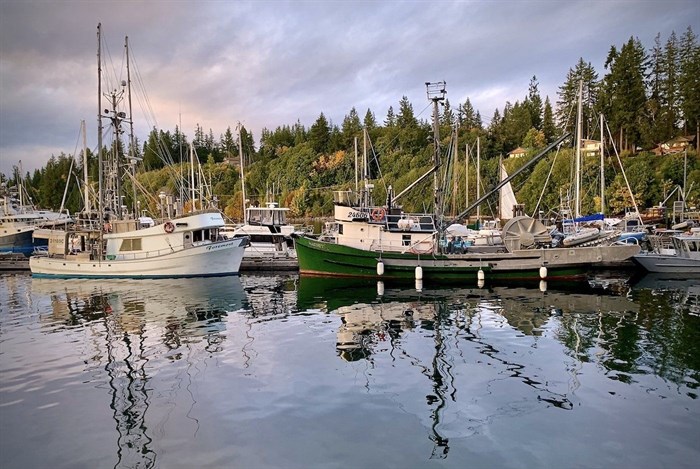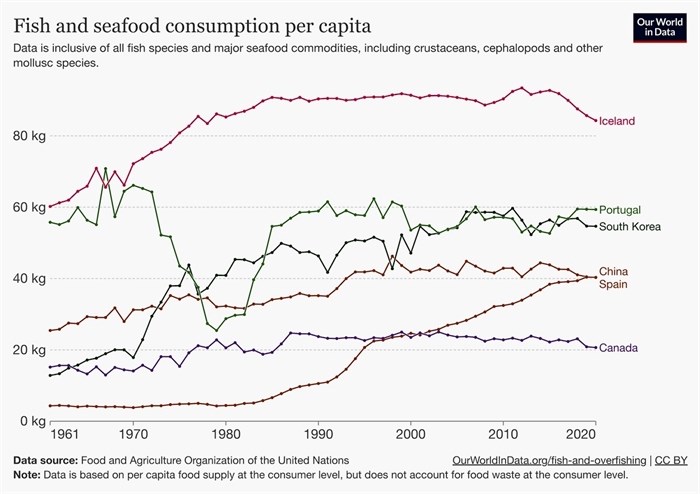
The pandemic fractured the global food chain, but Canadian consumers are still reliant on imported seafood while our high-quality products are exported overseas by the boatload, B.C. experts at a UN Food Day event said.
Image Credit: Rochelle Baker, Local Journalism Initiative
October 25, 2023 - 3:44 PM
A deep dive exploring how seafood can reach the tables of Canadian consumers and remain sustainable took place at a recent UN World Food Day event in Vancouver.
Keeping equity and the environment top of mind while creating a new ocean or “blue” economy was a key theme for panel experts at the day-long conference.
The pandemic’s disruption of the global food supply chain underscored how vital it is to develop local and regional seafood sovereignty and empower small-scale fisheries, said panel member Claire Dawson, Ocean Wise's senior manager of its fisheries and seafood initiative.
Canada’s seafood sector — whether fished or farmed — is geared to serve export markets or the restaurant industry, said Dawson.
This meant the survival of Canadian seafood producers and fish harvesters was on the line when access to international markets and restaurants slammed shut at the start of COVID-19, Dawson said.
Despite being a nation bordered by three oceans, Canadians eat less seafood than many other coastal nations, and often at restaurants rather than at home, she added.
Households, even in coastal communities, have limited access or opportunity to purchase nutritious, carbon-friendly and locally produced seafood — which threatens their food security if there are problems with the global supply chain.
Canadians trapped in a seafood swap
Paradoxically, most of the fish or shellfish Canadians do eat is imported, yet consumers have little clarity about how sustainable those products may be, Dawson said.
“What we eat is predominantly imported, and we’re exporting our high-quality seafood caught or farmed here.”
Canada exports 85 per cent of its seafood and is currently the fifth-largest exporter in the world, generating close to $9 billion in revenue in 2021. Lobster exports are king, making up close to 40 per cent of total seafood exports, followed by crab at 25 per cent, and salmon — the bulk is farmed Atlantic salmon — at 13 per cent.
In exchange, approximately 80 per cent of seafood Canadians eat — particularly salmon, shrimp and prawns, lobster, tuna and crab — is imported, the latest Fisheries and Oceans Canada (DFO) report shows.
The U.S. dominates the market, providing more than a third of Canada’s seafood imports, followed by China at 11 per cent, and then Vietnam, Chile and Thailand, with each providing between five and seven per cent.
This seafood swap offers Canadian consumers more choices and often at a cheaper price if they are farmed in other countries, the DFO report said.
However, panel experts stressed lower prices often carry a sustainability cost. The carbon footprint of imported seafood is greater than local alternatives and may be caught and processed in ways that are unfair to workers and damage the environment.
International fishing practices and seafood production processes run the gamut, but muddied and complex global supply chains increase the danger Canadians might be eating seafood tied to forced labour or illegal fishing, Dawson said.
“These products touch each and every one of our lives, so it's really important to know that your seafood wasn't caught or processed by slaves [and that it is] farmed in a way that is minimizing our impact on the environment.”
Studies by ocean conservation groups suggest inadequate labelling regulations expose Canadians to seafood fraud. Consumers can be tricked into paying a premium for certain products, even though testing reveals the products are often mislabelled and of inferior quality.
The federal government has come under pressure to create a boat-to-plate traceability program for seafood and in 2019, committed to improving the plan, but changes have yet to happen.
Large retailers often have more resources to guarantee their supply chains, and often develop responsible sourcing or labelling programs that exceed basic federal requirements, said Paul Lansbergen, president of the Fisheries Council of Canada.
One way for consumers to better understand the kind of seafood they’re buying is to look for certification logos — which may indicate whether a product is wild or farmed while others indicate the product’s origins and journey to market has been tracked, he said.
“That logo on the package means there’s a chain of custody and information [about the product] flows from one party to the next along the supply chain,” Lansbergen said.
Canada lacks a 'strong seafood culture'
But a push is on to try to get Canadians to eat more seafood and choose wisely, particularly products caught and processed by people and communities across the country, he said.
Nationally, the amount of seafood consumed has been in decline since peaking in the early 2000s, with Canadians eating 20.6 kilograms of fish and shellfish on a per capita basis in 2020, according to research mapping UN Food and Agriculture data.
Some small island nations top the global seafood consumption chart on a per capita basis, particularly in the Global South. However, a number of European and Asian nations still eat double the amount of seafood as Canada, a country rich in ocean resources.

Despite its wealth of marine resources, Canadians eat much less seafood than other nations and most of that is imported.
Image Credit: SUBMITTED
Ensuring future fisheries and aquaculture are sustainable both here and abroad is key given three billion people rely on seafood for food and their livelihoods, Lansbergen said.
“We actually don't have a strong seafood culture in Canada,” he said.
“Health Canada recommends that we eat two servings per week, but we're averaging just over one serving per week.”
The panellists were among numerous academic, First Nations, industry, environmental and policy experts participating at the event held by the University of B.C., Simon Fraser University and the United Nations Food and Agricultural Organization at the SFU Wosk Centre for Dialogue
— This story was originally published by Canada's National Observer.
News from © iNFOnews, 2023